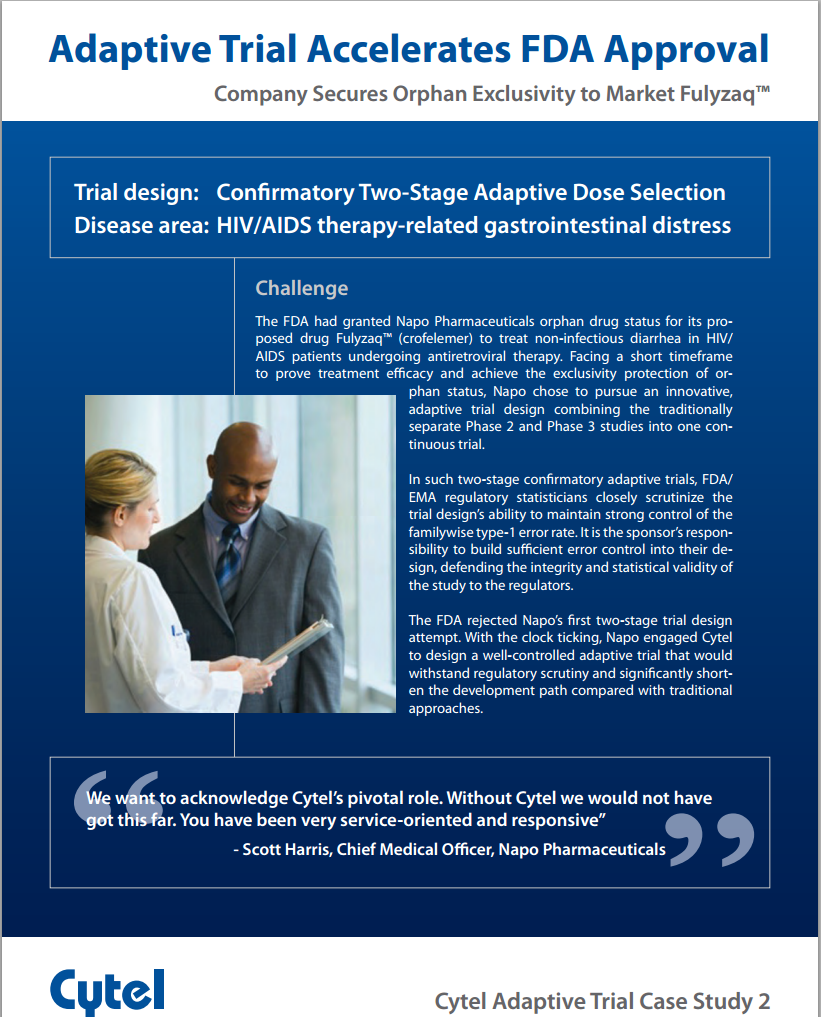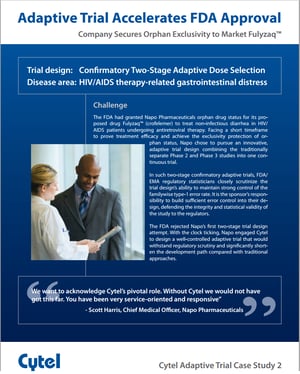Seamless Adaptive Clinical Trials: What’s really at stake?

Seamless adaptive clinical trials have gained popularity for reducing the projected time it takes to complete the process of drug development. However, a study by Cuffe et al., shows that despite a tremendous amount of statistical knowledge about seamless trials, sponsors remain unsure about how to calculate the financial and operational costs of a seamless clinical development program [1]. This in turn results in many unnecessary risks and missed opportunities. This post offers advice on what you need to keep in mind in order to implement a successful seamless adaptive clinical study.
What is a Seamless Trial?
Also called a combined-phase study, the idea behind a seamless trial is simple: Instead of conducting several phases of a study, plan one adaptive trial where the phases are separated by interim looks. This tends to save time and reduce the number of patients.
For example, the seamless Phase 2/3 ADVENT trial (click image at right to read case study), took a clinical program whose traditional design would have been four Phase 2 studies and one large Phase 3 study, and combined it into a four arm trial, which dropped the two less successful arms after the interim look [1]. The data obtained from the successful active arm prior to the interim look was able to play the dual role of confirming safety, and thereafter establishing efficacy. Employing a seamless adaptive late phase trial reduced sample size from 520 to 350 [2].
When conducting early phase trials, seamless proof-of-concept and dose-finding trials have also become more popular. Their benefit lies in the fact that combining these two trials into one larger trial allows significant reduction in trial time. Cytel Consultants recently reduced trial time by an expected 9-12 months (and 100 fewer patients) by employing such a design.
Want to read this article offline? Click the button below to download a pdf copy.
Varieties of Seamless Trials:
Most seamless trials can be split into two broad categories. An inferentially seamless trial is one where some of the data used prior to the interim look also plays an inferential role after the interim look. Consider once again the combined Phase 2/3 ADVENT trial. The four arm trial prior to the interim look was meant to establish safety. This means that the data from the arm chosen to continue to the confirmatory part of the trial played two roles: prior to the interim look it helped establish safety, after the interim look the same data from this arm, combined with the data collected post-look, also helped to establish efficacy. As a result, the two look trial was inferentially seamless.
An operationally seamless trial, by contrast, is one where the data evaluated after the interim look is kept distinct from the data evaluated prior to the interim look. Each set of data has its distinctive purpose.
The Purported Inflexibility of Seamless Studies:
The flexibility of an adaptive design is often touted as one of its greatest advantages [3]. Based on data collected at an interim look, DMC’s can decide how to move forward in a manner which gives the new drug, device or biologic the best possible chance to prove its safety or efficacy.
Seamless studies are beneficial for reducing sample size and increasing the speed of the trial. Unlike other adaptive designs, however, seamless studies may be somewhat less flexible. This is particularly true for inferentially seamless trials. Cuffe et al., cite two reasons for this:
- In traditional trial designs, clinical trial sponsors are able to look at the entire set of data collected after a given phase, and make key decisions about the designs of the phases that follow. By contrast, unless seamless adaptive studies allow for data to be unblinded at an interim look, DMC members must rely on go/no-go decision rules for the second stage of the trial. These rules will have to be determined even before the first stage of the trial begins, which means it may not be possible to take advantage of all of the information which the first stage can provide.
- In inferentially seamless trials, the final analysis combines a part of the data that was collected prior to the interim look with data collected post-interim look. In order to use this data, certain constraints must be placed on the entire trial design. As Cuffe et al., explain, "[I]t is worth noting that a seamless study allows only limited changes to the Phase III portion: substantial changes to study conduct can mean that the two portions answer different clinical questions." [1]
The fact is that in a combined phase study, the basic structure of the post-look portion of the trial has to be determined prior to the interim look. Unlike in a traditional clinical program, a combined Phase 2/3 trial may not allow sponsors to look at all of the unblinded interim data to take advantage of new information which could affect design decisions.
Overcoming the Inflexibility of a Seamless Study:
Although there is no doubt that seamless trials place certain restraints on late phase trials, sponsors have several reasons to employ a seamless design.
- Early Phase Advantages: Cuffe et al., find that in practice, many of the restrictions cited above only apply to late phase studies. Their findings reveal that an early phase seamless adaptive study 'incorporated multiple adaptations and took advantage of safety data from a dose-escalation study to increases the range of doses in the second portion...' [1]
- Late Phase Advantages: Although late phase seamless studies might not allow for as much flexibility as other adaptive trials, they have the potential to reduce sample size rather dramatically. In the Phase 3 ADVENT trial designed by Cytel, the use of a seamless study reduced sample size from 520 to 350. Securing a significantly smaller trial made the inflexibility worth it for the sponsors of the ADVENT trial.
Liked this article? Click below to download our 2017 paper 'Are adaptive trials the answer to oncology development success?'
Related Items of Interest
[1]: Cuffe, Robert L., et al. "When is a seamless study desirable? Case studies from different pharmaceutical sponsors." Pharmaceutical statistics 13.4 (2014): 229-237.
[2]Operationally Seamless & Inferentially Seamless Adaptive Designs
[3] 5 Scenarios When ‘Keep it Simple’ May Be Bad Advice for Clinical Trial Designers




